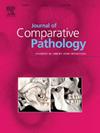来自野生动物救助站的双趾树懒(Choloepus didactylus)的过度角化性胃炎。
IF 0.8
4区 农林科学
Q4 PATHOLOGY
引用次数: 0
摘要
蛞蝓亚目哺乳动物是树栖物种,主要以树叶为食,巴西亚马逊地区盛产的一种植物 Cecropia spp 是它们的最爱。树懒的胃占其体重的 20-30%,适应植物材料的胃发酵。在圈养条件下,这些解剖学和生理学上的适应性会因许多因素而改变,从而导致致命的胃病。本研究的目的是描述野生动物救助中心的三只两趾树懒(Choloepus didactylus)的胃部解剖病理变化。尸体解剖显示,胃黏膜厚度差异很大,大面积呈乳头状。组织病理学显示,胃腺体区域的分层鳞状上皮角化过度,淋巴细胞和浆细胞浸润。组织病理学诊断为慢性角化过度性胃炎,这在树懒中以前从未报道过。反复接触食物中的抗原、药物、化学物质、毒素或感染性物质会引发过敏或免疫介导的反应,最终导致这些动物患上慢性胃炎。本文章由计算机程序翻译,如有差异,请以英文原文为准。
Hyperkeratotic gastritis in two-toed sloths (Choloepus didactylus) from wildlife rescue
Xenarthran mammals of the suborder Folivora are arboreal species that feed mainly on leaves and Cecropia spp, an abundant plant in the Brazilian Amazon region, is favoured. The stomach of sloths represents 20–30% of their body weight and is adapted to gastric fermentation of plant material. These anatomical and physiological adaptations can be altered by many factors when confined to captivity, which favours fatal gastric conditions. The objective of this study was to describe the gastric anatomopathological lesions in three two-toed sloths (Choloepus didactylus) from a wildlife rescue centre. Necropsy revealed wide variation in the thickness of the gastric mucosa, with large areas having a papilliform appearance. Histologically, hyperkeratinization of the stratified squamous epithelium of the aglandular gastric region and infiltration of lymphocytic and plasmacytic cells were seen. The histopathological diagnosis was chronic hyperkeratotic gastritis, which has not previously been reported in sloths. Repeated exposure to dietary antigens, drugs, chemicals, toxins or infectious agents can initiate allergic or immune-mediated responses that can ultimately lead to chronic gastritis in these animals.
求助全文
通过发布文献求助,成功后即可免费获取论文全文。
去求助
来源期刊
CiteScore
1.60
自引率
0.00%
发文量
208
审稿时长
50 days
期刊介绍:
The Journal of Comparative Pathology is an International, English language, peer-reviewed journal which publishes full length articles, short papers and review articles of high scientific quality on all aspects of the pathology of the diseases of domesticated and other vertebrate animals.
Articles on human diseases are also included if they present features of special interest when viewed against the general background of vertebrate pathology.

 求助内容:
求助内容: 应助结果提醒方式:
应助结果提醒方式:


